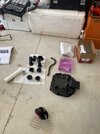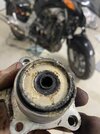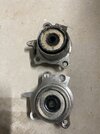I want to give a big shout out to (Larry) Igofar for helping me in my time of need as I put my 2004 ST back together from the faulty water pump replacement (impeller depth improperly set) as I drove the bike on the road after reassembling had a serious clutch slipping issue and I had replaced the friction plates(EBC) and their spring kit ???? Well I missed a few key parts at least 2 out of 3 bevel spring and pressure plate order and direction. Steel plate have a particular direction and the last is the position of the final clutch plate in the shallow groove not in the deep groove with all other plates. I measured all of the oem plates and reused them 115k and still in the almost new spec. I chose to reuse the stock springs as the replacements were 4mm shorter than stock and didn't want to take a chance as it was not slipping before. After reassembling with the verified used parts the clutch was working as it should. Thanks to my good friend Sidekick fo having the patience and the time and referring me to
You are using an out of date browser. It may not display this or other websites correctly.
You should upgrade or use an alternative browser.
You should upgrade or use an alternative browser.
Igofar Reviews
- Thread starter kscssmith
- Start date
I would also like to thank Larry for his assistance in helping me get my ST back on the road. I was planning on going to the BRG this year and in preparation I figured I would start putting so time in on the bike. Never had any issue with it running, until my planned trip to the BRG which I was really looking forward to. I go to start the bike and it won't even hardly start or stay idling on its own. It seems like something must seriously must be wrong and now I'm stressed out over the situation with the bike and the trip. I knew Larry was having some medical issues and although I was pretty sure he could diagnose it over the phone, I didn't want to bother him with my bike issues when he was having his own issues to deal with. So I posted about my bike on the forum here, and along with other helpful members, Larry responded and volunteered to help me figure out the issue even though he was not up to 100%. He immediately was sure it was the five way tee needed cleaning and walked me through the process. He was 100% right. It run like a champ after following his step by step instructions. What a relief off my mind. Saved me from having to carry it to the stealership and I understand better how my bike works and know the work was done right because it was directed by Larry! Thank you very much Larry! Your assistance is truly appreciated! I hope your doctors are able to help you as much as you help all of us at ST-Owners.
Sincerely,
B.R.
Sincerely,
B.R.
I too, owe Larry a huge debt of gratitude for his help with fixing my ’06 ST1300 braking system. It started with me changing out the rear brake pads which resulted in heavy brake drag. I dove into rebuilding the rear caliper with one new piston, new piston seals, rubber boots and caliper spring – still they dragged. After an SOS message on the Forum, Larry reached out: “hold my beer, I got this” he told everyone else.
Let’s see, there was a new SMC (of course), rear bracket sub-assembly, numerous other small parts including brake line crush washers (there is a top and bottom), and stuff you wouldn’t know about like what to grease, what not to grease, don’t grease too much, the correct angle of the SMC for bleeding, AND correcting the shop manual like torquing the rear caliper brake slide to 20 lbs., not 51 lbs. and the order in which to bleed the brakes.
After numerous bleeding go-arounds, the whole system is working well. What I thought would be a simple pad change evolved into this giant brake system re-build – frustrating but a great experience. I could not have done it without Larry. He is oh so patient and calm and the guitar music he plays in the background while I’m executing his latest instruction helped keep me calm.
Larry, I hope you are well and recovering from whatever it is you are fighting. Best to you, thank you!!
Jack
Let’s see, there was a new SMC (of course), rear bracket sub-assembly, numerous other small parts including brake line crush washers (there is a top and bottom), and stuff you wouldn’t know about like what to grease, what not to grease, don’t grease too much, the correct angle of the SMC for bleeding, AND correcting the shop manual like torquing the rear caliper brake slide to 20 lbs., not 51 lbs. and the order in which to bleed the brakes.
After numerous bleeding go-arounds, the whole system is working well. What I thought would be a simple pad change evolved into this giant brake system re-build – frustrating but a great experience. I could not have done it without Larry. He is oh so patient and calm and the guitar music he plays in the background while I’m executing his latest instruction helped keep me calm.
Larry, I hope you are well and recovering from whatever it is you are fighting. Best to you, thank you!!
Jack
Larry has spent much of his time on the phone with me helping me through brake and heat problems. He is a great asset to this group. Thank you.
CruisingDog
CRZNDOG
Larry has been so helpful in instructing me on how to sort a few issues out. I really appreciate the help and have only so far done a couple of minor jobs due to limited time. Replaced the preload damper oil and he was right, it was very low on oil after being so old. Thanks Larry. I’m sure I’ll be giving you a shout when I get onto the bigger jobs!
Just for the record, it was strongly suggested that the brake line be replaced for safety reasons, and for whatever reason he didn’t want to replace it at the time, so I warned him to keep an eye on it.
Something like this would not have left my lift table, but that’s just me.
Something like this would not have left my lift table, but that’s just me.
cneher
Clint Neher
Hey brothers, figured I’d drop a line to share what’s been going on in my world - I feel so incredibly blessed!
My 9yr old is riding dirtbikes now, my 6yr old is just about to start riding ATV’s, and my 11yr old is a little gun shy with dirt bikes & atv’s - but loves the go-kart
I’ve got a buddy coming out tomorrow with his skid steer and we’re going to clear out a little dirt bike track on our property (I’ll post some pictures when it’s done). Brothers - my kids are living my dream childhood - so freaking cool!
On another note - it seems there’s been a little miscommunication about my brake line on my motorcycle. I want to clear the air that Larry told me to change that brake line - but I communicated I won’t be able too right away due to finances & time - so he told me to keep an eye on it and get it done as quickly as possible.
I want to shine a little light on how much @Igofar (Larry) has helped me grow my confidence to work on the ST - as well as @aniwack (John) - a man that Larry coached and is now having the same sort of impact Larry has and has helped me replace the clutch slave cylinder, sync the starter manifolds, and replace a valve cover gasket.
They take time out of their day (which is a limited resource we can never get back) to serve people in many different ways. Heck, I was having a rough day with my kids and Larry sensed the stress in my voice and offered to do a magic trick for my children on FaceTime to give me a little bit of reprieve.
Brothers, that’s real legacy right there - a legacy of real significance. I hope to serve in that way as well.
God bless you Larry and John.








My 9yr old is riding dirtbikes now, my 6yr old is just about to start riding ATV’s, and my 11yr old is a little gun shy with dirt bikes & atv’s - but loves the go-kart
I’ve got a buddy coming out tomorrow with his skid steer and we’re going to clear out a little dirt bike track on our property (I’ll post some pictures when it’s done). Brothers - my kids are living my dream childhood - so freaking cool!
On another note - it seems there’s been a little miscommunication about my brake line on my motorcycle. I want to clear the air that Larry told me to change that brake line - but I communicated I won’t be able too right away due to finances & time - so he told me to keep an eye on it and get it done as quickly as possible.
I want to shine a little light on how much @Igofar (Larry) has helped me grow my confidence to work on the ST - as well as @aniwack (John) - a man that Larry coached and is now having the same sort of impact Larry has and has helped me replace the clutch slave cylinder, sync the starter manifolds, and replace a valve cover gasket.
They take time out of their day (which is a limited resource we can never get back) to serve people in many different ways. Heck, I was having a rough day with my kids and Larry sensed the stress in my voice and offered to do a magic trick for my children on FaceTime to give me a little bit of reprieve.
Brothers, that’s real legacy right there - a legacy of real significance. I hope to serve in that way as well.
God bless you Larry and John.








I just took the first ride on my ST since IGOFAR talked me through a complete brake job including:
•rebuild rear caliper
•install new SMC
•old fluid removed and master cylinders cleaned
•new OEM pads installed
•completely bleed the system using the lever and pedal only
•clean and re-lube rear pumpkin gears and install new bearing
•safety test the braking system
Unbelievable difference in the “feel” of the bike. So much smoother and the rotors are staying so much cooler.
THANK YOU IGOFAR (Larry). I look forward to the next upgrade with your guidance.
ScottST
OH YEA, he was also right about loose fasteners in my saddle bags. No more pushing closed with my leg

•rebuild rear caliper
•install new SMC
•old fluid removed and master cylinders cleaned
•new OEM pads installed
•completely bleed the system using the lever and pedal only
•clean and re-lube rear pumpkin gears and install new bearing
•safety test the braking system
Unbelievable difference in the “feel” of the bike. So much smoother and the rotors are staying so much cooler.
THANK YOU IGOFAR (Larry). I look forward to the next upgrade with your guidance.
ScottST
OH YEA, he was also right about loose fasteners in my saddle bags. No more pushing closed with my leg

Thanks to Larry, I purchased a 2006 Yamaha Stratoliner from his brother. After sending him a message, Larry connected me to his brother. He checked in before and after the sale. He was helpful, friendly and courteous every step of the way. The bike was in great condition, had no issues, and Larry had a detailed maintenance log. I couldn’t have asked for a better experience overall, two thumbs up for Larry.
I obtained a 2005 ST from my father. The motorcycle only had 3K miles on it and had been sitting in a garage for probably the last 10 years. I posted on the ST forums prior to taking delivery of the motorcycle asking what I should be looking at when bringing it back to riding life. Larry responded to me and told me to reach out to him about this. When I got the bike I called Larry and found out that he lives in Tucson and I am not far away in the Tucson area. We agreed on a date and time last month and I brought the motorcycle up to him. We spent the day going over the motorcycle to make sure it was road worthy. He showed me how to do all of the regular maintenance items such as the proper brake bleed sequence so that I can competently do it my self in the future. He showed me all the little tips and ins and outs of the bike which is super helpful. When checking fork alignment he found that there was an issue with the front axle probably caused at a dealership during setup. He got the issued corrected but it took some work.
It was a long day but I know my motorcycle is definitely road worthy now and I know have a wealth of knowledge so that I can do all the routine maintenance myself properly. I very much appreciate Larry spending the time with me on my motorcycle. Larry is very helpful, courteous and friendly. I know I can call him anytime I have an issue and he will be there to answer my questions or just have a friendly chat. If you have an issue with your ST, definitely hit him for help!! Thank you Larry!!
It was a long day but I know my motorcycle is definitely road worthy now and I know have a wealth of knowledge so that I can do all the routine maintenance myself properly. I very much appreciate Larry spending the time with me on my motorcycle. Larry is very helpful, courteous and friendly. I know I can call him anytime I have an issue and he will be there to answer my questions or just have a friendly chat. If you have an issue with your ST, definitely hit him for help!! Thank you Larry!!
Da Roadglide
Site Supporter
I want to take the time to thank IGOFAR for all the help that he provided me the past month. With his advice and tips, replacing the Clutch Slave Cylinder was actually quite easy. It was matter of having the right tools, which he made sure I had before I started and following some helpful tips which made the job much easier. I am not a mechanic and never claimed to be, but Larry walked me through several other issues. At times he just let me figure thing out, because he knew I would and other times he called me to check on my progress. Larry's knowledge of the ST1300 workings goes way beyond the been there done that. He understands why things are as they are, what can be done to improve them and what people like me shouldn't be messing with. I was frustrated at times and Larry's calm and methodical demeanor helped me through it all. I now feel I have both a reliable and safe bike thanks to IGOFAR. Thank you so very much, I appreciate everything that you did for me.
Once again, Igofar saved me money by correcting me I what I thought was a master clutch cylinder leak. It ended up being a leaking cover. Larry also sent me a list of parts I should replace. Great job @Igofarant thank you very much for your help.
Ron
Ron
Share:
